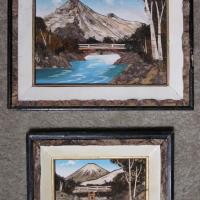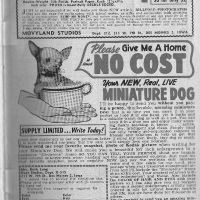Thought we would take a little detour here, as I seemed to be gathering rather a pile of things that fit into this category, and were begging me to make a post of them. I think we will have a little game here. I will post the picture, and give you a chance to guess what it is before we move on the explanation. Let’s start here:
Out of the box, these present some serious conundrums. The posts on the sides of each of the three squares are retractable, and the long thing is vaguely needle-like, so what could it be? Why a granny square loom, of course:
Now, looking at the instructions, there is absolutely NO WAY on God’s green earth that they are going to come out looking like the picture on the box. I guess we are going to have to take their word for it, that it is magic. I have used a similar loom that made round daisies in the ’60s and they came out pretty cute. The jury is out on this one. I haven’t tried it yet. All those granny square patterns are probably safe from this.
These could be a set of fingernails?
Yet another needle thingy, and I have to let you know it is missing the “pure” latex bands that hold the wire parts in place. This one may actually work:
These were for making rag rugs. It says you can braid all weights of fabric because of the adjustable wires. It would probably work. I actually liked the box more than anything. That is probably pretty warped on my part, so sue me.
By now, you can tell that we are playing with sewing items from the near and distant past. The whole idea started with this book that showed up in a bag of sewing books and patterns. Who can resist a bag of sewing books and patterns? Not us!
I’m a Singer girl, two sewing machines and a serger, so I knew this would be useful, and what do you know, I did learn something. First up, this:
No, seriously, is this not the most wicked-looking thing you have ever seen? I own two of these (no really!). One fits my old treadle Singer and I just got the other one, as it was low shank foot, and I knew it would fit my newer Singer machine, but once I had it, now what? I did know what it was, but now I know what to do with it:
Yes, it’s a ruffler. It even sounds fun doesn’t it? Here is another page on how to use it:
I bravely attached it to my machine, and what do you know? Ruffles:
It can do ruffles of varying degrees and you can set it to do pleats as well. Honest, it worked like a charm. You can even set it up to do the ruffle or pleat, and attach it at the same time:
One seam! Why do these things not come with new machines? If you have a low shank machine go find yourself a Greist or Singer ruffler at once!
This next one was not so successful, at least in my book:
This little dohicky is made to attach binding. Here is the info:
I tried it with some modern cotton binding and there was no way it was EVER going to work, but I found some rayon, or something like it, double-fold tape in my stash and it did attach it neatly:
It’s a little tricky to use, but I could see it working with practice, but only with finer materials and smaller sizes than modern bias tape comes in.
I learned to use one of these when I first started to sew, it’s another wicked-looking device, isn’t it?
These old buttonholers were a godsend, as before them, buttonholes were hand sewing at its most tedious. These have cams that you drop in a spot in the back to set it up to do the correct size of buttonhole. Along came the new machines with “built in buttonholers” and these went by the wayside. Well, let me tell you, it’s worth going and finding one of these. At least my machine just moves the needle from side to side: you have to tell it where it start, where to stop and where to do each end. You attach this, put your foot down and instant buttonhole:
Clean and neat, and every one the same. Oh Singer, are you listening?
Here we have another crazy miss:
My first guess was a tuning fork! Not really. I found the first one with instructions, so I knew what the second one was when it showed up in a sewing box. Here we go:
Yes, a handy-dandy hemstitcher. I have read the instructions from top to bottom, and other than the insistence that it is will make your life easier, I can see no evidence of this being a help. Check out the closeup:
 Just fold the fabric over and stitch between the bars. Couldn’t you just fold the fabric over and stitch without messing with a piece of metal? Imagine trying to keep your presser foot on top of the dratted thing. On top of that you have to loosen your top tension on the machine to make it work, so you have a LOOSE hem. The envelope says it cost a whole dollar, and we know that at least two people (well, make that three if you count me) purchased one. I am pretty sure the total number of times it has been used is way less than that! By the way, they even had the nerve to patent it!
Just fold the fabric over and stitch between the bars. Couldn’t you just fold the fabric over and stitch without messing with a piece of metal? Imagine trying to keep your presser foot on top of the dratted thing. On top of that you have to loosen your top tension on the machine to make it work, so you have a LOOSE hem. The envelope says it cost a whole dollar, and we know that at least two people (well, make that three if you count me) purchased one. I am pretty sure the total number of times it has been used is way less than that! By the way, they even had the nerve to patent it!
I hope even the non sewers had a little fun looking at some of these, and for those who do sew, maybe you will be on the hunt for a new toy soon!






























I adore the sewing machine “torture devices” as they really are quite ingenious. I have a couple of those for my old Kenmore machine. But, I do NOT have the kind of patience to learn how to use them and use them well. I just don’t sew enough these days. Sewing is, to me, pure aggravation if it’s anything more than a straight seam. lol Looking forward to seeing you soon! – Dawn
We are looking forward to seeing you, too! Sewing can be fun when it’s going well, BUT when it’s bad, it’s horrid. 😉
I NEED a ruffler!!!!!